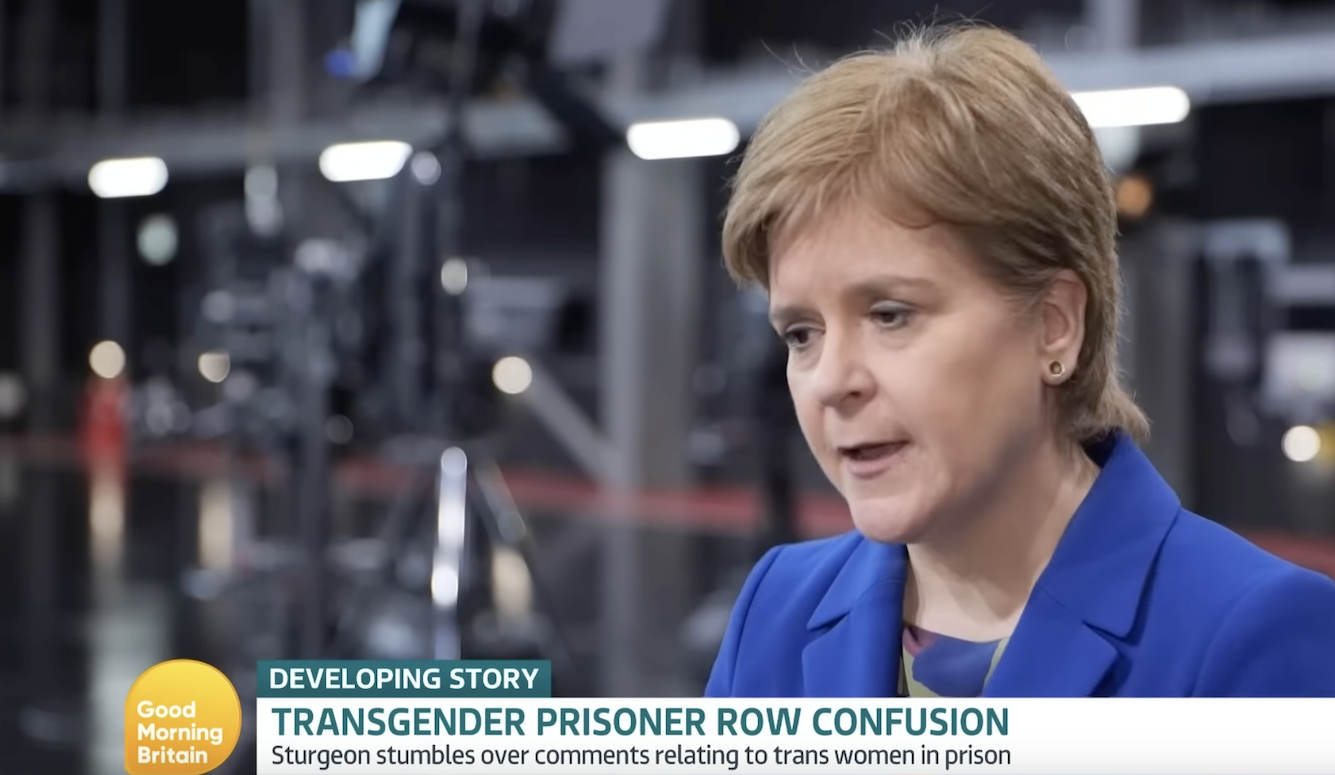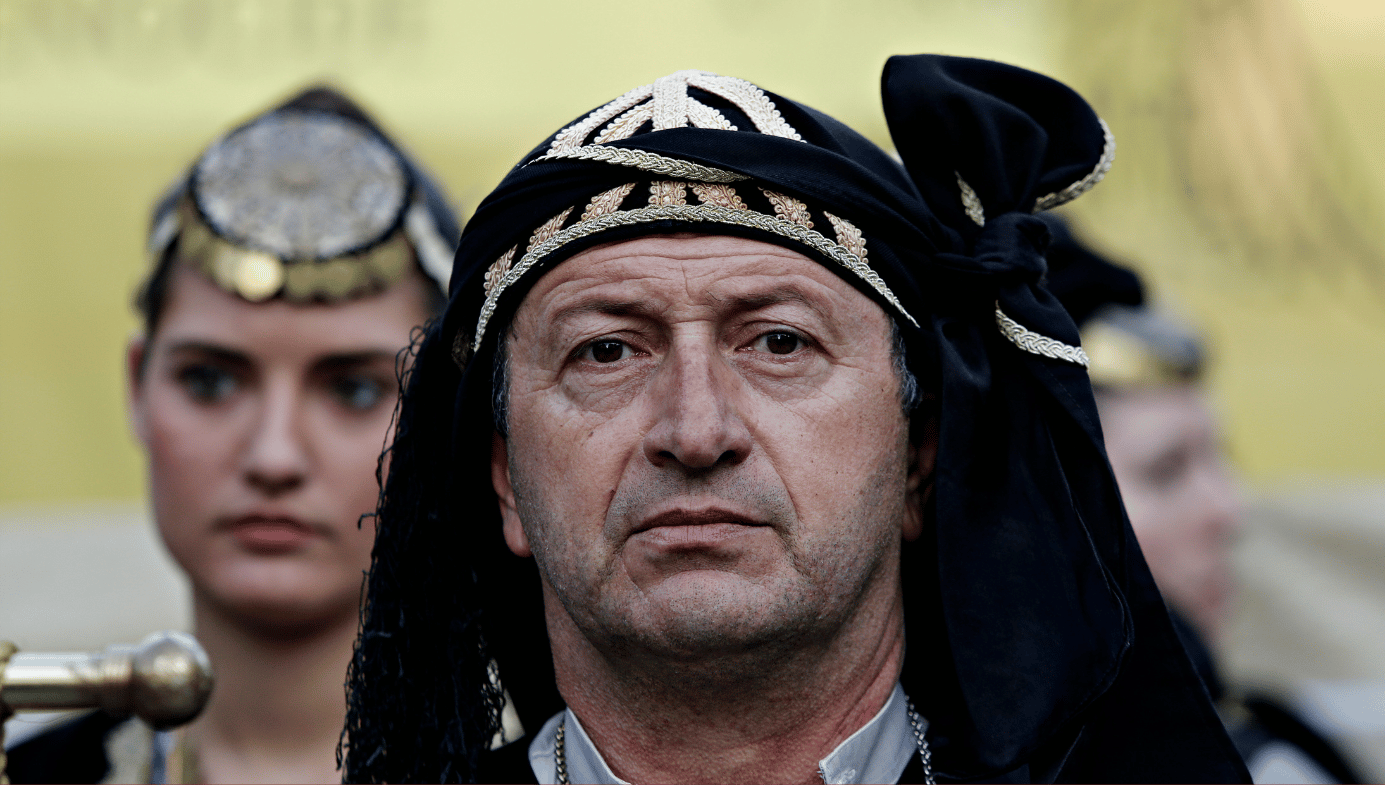Scotland’s Gender Meltdown
Nicola Sturgeon championed a policy of letting biological men into protected female spaces. Now she’s paying the price for her dangerous folly.

Scotland is a small country with a rich intellectual tradition. It had its own Enlightenment, producing philosophers such as Adam Smith and David Hume, while its novelists—Walter Scott, Robert Louis Stevenson, Arthur Conan Doyle—became towering literary figures. What they would have made of the scandal currently convulsing Scotland is anyone’s guess, but you don’t have to be Sherlock Holmes to work out that a shaven-headed sex offender in a blond wig is actually a man. Adam Graham’s photograph, with and without the wig, has been splashed across front pages, TV screens and mobile phones for days since his trial for rape at the High Court in Glasgow, accompanied by growing skepticism about his claim to be transgender.
Trans woman Isla Bryson has been found guilty of raping two women but will be sent to a women's prison.
— TalkTV (@TalkTV) January 25, 2023
Julia: "We got told this wouldn't happen - and that we were all transphobic bigots! That's a man who now pretends he's a woman."
@JuliaHB1 pic.twitter.com/lrXY04AO1C
The reluctance of leading Scottish politicians to break ranks and admit that Graham is male has turned them into a laughing stock. The country’s First Minister, Nicola Sturgeon, couldn’t even bring herself to use his name, telling the Scottish Parliament: “I’m not going to get into the individual circumstances of that particular individual’s claims to be a woman because I don’t have enough information about that.” Some observers would respond that the fact Graham has been convicted of raping two women is a pretty strong clue about his sex.
Graham appeared in court under the name Isla Bryson, showing how successfully trans ideology has captured Scottish institutions. The judge addressed him as “Ms. Bryson,” and he was even remanded to a women’s prison, until an outcry prompted his transfer to the male estate. The Scottish government has now been forced to announce a pause in its policy of housing trans-identified male prisoners in women’s jails, yet a six-foot-five trans woman who assaulted a 10-year-old girl and secretly filmed a 12-year-old in a supermarket toilet remains in the women’s estate.
It is a story from which few in the governing coalition, made up of the Scottish National Party and some decidedly eccentric Greens, emerge with credit. It confirms all the warnings offered at the end of last year, when their wildly irresponsible bill to remove current safeguards governing the process of changing legal sex was passed in the Scottish Parliament. For reasons many people are struggling to understand, ministers staked their reputations on pushing through the Gender Recognition Reform (Scotland) Bill, ignoring not only its likely impact on women’s services, but also warnings that the legislation would probably be blocked by the Westminster government in London. That’s now happened, adding a constitutional crisis to the farcical events of recent weeks.
Katie Dolatowski, who identifies as transgender, avoided prison after admitting to grabbing a 10 year-old girl by her face and forcing her into a restroom cubicle before demanding she take her trousers off. KD also filmed a 12 year-old girl in the toilets.https://t.co/mHevFHNop8
— Women's Voices (@WomenReadWomen) April 17, 2021
Sturgeon has been left fighting for survival, looking weaker by the day. Instead of showing contrition, she has lashed out at critics of the legislation, many of them feminist organisations, smearing them with accusations of misogyny, homophobia, and racism. The row has wider lessons because other countries are adopting similar legislation that erases the difference between men and women, substituting vague nonsense about “gender identity.” But it also highlights a crisis in politics, showing how easily unwary politicians can be captured by fashionable ideology. Labour in Scotland could have abstained on the bill, but most of its MSPs (Member of the Scottish Parliament) voted in favour, apparently against the advice of the Labour party in London.
The speed of the meltdown in Scottish politics is remarkable. As recently as December, Sturgeon and her Green colleagues were cock-a-hoop, dismissing opponents of their bill as “transphobic.” The legislation would replace the requirement for a medical diagnosis of gender dysphoria with unfettered self-identification, allowing any man to declare himself a woman after living for just three months in his “acquired” identity. No one knows what the latter phrase means, although it has been suggested that it could amount to no more than switching to a female name on a utility bill. MSPs refused to accept amendments that would have prevented men accused of sexual violence from starting the process of declaring themselves women (thereby forcing their victims to refer to them using female pronouns in court). They angrily rejected the idea that sexual predators would abuse the legislation to serve their sentence in a women’s prison, potentially allowing them access to fresh victims. None of these things would ever happen, the zealots insisted. But then they did.
Clearly ministers had not reckoned on someone like Graham turning up, embodying all the warnings about predatory men abusing self-ID. He even (and somewhat ill-advisedly) wore tight leggings to court, making it clear to the world that he has not undergone surgery.
Picture = 1,000 words https://t.co/hjUQfmVF7r pic.twitter.com/w7ueoR2HJz
— Jonathan Kay (@jonkay) January 24, 2023
He has not even taken female hormones, confirming the fact that his “transition” consists of nothing more than a new name and an unconvincing wig. Uproar ensued as most media outlets followed the court’s direction and used female pronouns in their reports of the case; nothing could have exposed the lunacy of the times we are living in more vividly than headlines referring to “her” penis. Some journalists, myself included, refused to join in, using male pronouns in articles about Graham. It quickly became clear that the public, which opposes the Scottish legislation according to opinion polls, is on our side.
Graham lasted one night in Cornton Vale women’s prison before Sturgeon, visibly reeling from a barrage of criticism, announced that he was to be transferred to the male estate while a “risk assessment” was carried out. (If the Gender Recognition Reform (Scotland) Bill had received royal assent, this move would have been impossible: men such as Graham would in future be able to acquire a certificate stating that they are female and so mount a legal challenge to the decision to house them in a male prison.)
Graham had barely arrived at an all-male establishment when news broke that another “trans” inmate had been cleared to move to the female estate. Andrew Burns, who now calls himself Tiffany Scott, is one of the most dangerous prisoners in Scotland; photos show him bare-chested, in handcuffs, looking like a still from The Silence of the Lambs. Originally convicted of stalking a 13-year-old girl, he has assaulted inmates, prison officers, and nurses in jails across the country since being convicted; he is banned from appearing in court in person after he bit into a vein and spat blood at prison officers. Scott has been trying to get a transfer to a women’s jail for years. With exquisitely bad timing, the Scottish Prison Service (SPS) relented just before the Graham case blew up. It has now paused the movement of all transgender prisoners, including Burns, while a “review” takes place.
“Until the review is completed, any trans individuals with a history of violence towards women will only be admitted to the male estate, in segregation, when they first enter our care,” an SPS spokesman said. Sex-segregated prisons have existed for two centuries in the UK, so why the service needs a “review” to decide where male offenders should be housed is anyone’s guess. But common sense evidently departed from Scotland a long time ago.
How did Scottish politicians get into this mess? Critics point to the fact that the SNP is adrift, with a leader who will probably step down before the next UK-wide general election and is desperately in search of a legacy. The party lost an independence referendum in 2014 under its previous leader, Alex Salmond, a defeat that raised questions about what the SNP is for if it cannot persuade a majority of Scottish voters of the wisdom of leaving the UK. The party has since been torn apart by in-fighting, with Sturgeon and Salmond becoming sworn enemies after he was accused, and cleared, of numerous counts of sexual assault. Salmond has now formed a new party, Alba, which has had zero electoral success but remains an irritant.

Despite her plummeting popularity, Sturgeon retains tight control of the party through her husband, Peter Murrell, who is its CEO. Why party members put up with what appears to be an obvious conflict of interest is hard to fathom, but it places formidable obstacles in the way of any challenge to the First Minister. A clue to the origin of Sturgeon’s current embarrassment may lie in an amateurish video she made two years ago. Looking tense and anxious, she said she had just heard that day about “significant numbers” of young people leaving the party because they didn’t think it was “a safe, tolerant, or welcoming place for trans people.” In what some observers compared to a hostage video, she pleaded with them to “come home,” giving the impression that she was panicking over not appearing sufficiently trans-inclusive. She is not the only party leader to assume that bowing to the demands of trans activists is an easy win among voters, although that proposition is looking shakier by the day.
It also feels like a distraction. The SNP has been in power, in either minority or majority form, since 2007, giving it ample time to demonstrate how hopeless it is at running the country. Scotland has one of the highest rates of drug deaths in the developed world, high levels of poverty, and poor exam results for children from deprived areas. The government is embroiled in scandal over its failure to deliver new ferries for the Scottish islands, which are five years overdue, and this “ferry fiasco” has become shorthand for the SNP’s incompetence. It desperately wanted another shot at independence; which is why, two years ago, when it fell short of a majority in elections for the Scottish Parliament, it formed a power-sharing agreement with the Greens, giving them two ministerial positions.
In the event, the coalition’s attempt to get a second independence referendum was blocked by the UK Supreme Court. But the underlying arrangement means that two of the country’s most high-profile supporters of gender ideology, Green MSPs Patrick Harvie and Lorna Slater, are now at the heart of the Scottish government. They are keen advocates of the GRR bill and have repeatedly attacked its opponents, including author J K Rowling, who lives in Edinburgh. She has been a hate figure for trans activists for years, receiving death and rape threats, and being doxed on social media, a situation that’s gotten dramatically worse since the GRR bill was blocked by Westminster.
Last March, Slater and Harvie (falsely) accused Rowling of opposing “trans people’s equality and human rights.” Slater, who is Minister for Green Skills, Circular Economy, and Biodiversity, has also accused critics of the legislation of “putting trans lives at risk.” These are smears, wearily familiar to feminists who oppose the abolition of women’s sex-based rights elsewhere in the UK. In 2020, the SNP’s then deputy leader in the House of Commons, Kirsty Blackman MP, signed an open letter accusing the BBC of being “institutionally transphobic” after it quoted me in an article that appeared on the BBC website. Who knew feminists had such power?
The false notion that transgender people don’t have full human rights in the UK is frequently deployed by supporters of gender ideology in other mainstream parties, including the Labour Mayor of London, Sadiq Khan. In 2021, I was sacked as co-chair of the Mayor’s Violence Against Women and Girls Board, an unpaid role I’d carried out for eight years, after I wrote to Khan warning him about the chilling effect of his insistence that “trans women are women.”
Trans women are women.
— Mayor of London, Sadiq Khan (@MayorofLondon) February 16, 2020
Trans men are men.
Non-binary people are non-binary.
All gender identities are valid.
#LGBTHistoryMonth
The same slogan has been repeated endlessly by leading Labour politicians, along with threats to expel members deemed to be “transphobic.” The party’s leader, Sir Keir Starmer, even trotted it out in a meeting with military leaders in Estonia last year, during a visit to discuss Russia’s invasion of Ukraine. In reality, which doesn’t get much of a look-in from activists, transgender people have exactly the same legal rights as everyone else. Statistics show they are one of the safest demographics in the UK (unlike women, two or three of whom are murdered every week).
Critics of the SNP, and former supporters who are aghast at recent events, speculate that Sturgeon thought that introducing self-ID in Scotland would secure her place in history. (It may yet do that, though not in the way she expected.) They point to the fact that men who claim to be women have been allowed to serve their sentences in women’s prisons since 2014, something that went largely unremarked by the general public. Mistaking silence for consent is a rookie mistake on the part of a politician, but few people outside the political establishment had any idea what was going on. There was a wake-up call two years ago when a trans woman, Mridul Wadhwa, got a job as CEO of Edinburgh Rape Crisis, a role that was supposedly open only to female applicants. Wadhwa immediately waded into controversy by suggesting that “bigoted” rape survivors should be “re-educated” about trans rights and needed to “reframe” their (male-induced) trauma.
A Green MSP, Maggie Chapman, sprang to Wadhwa’s defence, accusing critics—who had the temerity to suggest that the welfare of rape victims should be the service’s priority—of spreading “misinformation” based on “ignorance, bigotry, and hatred.” Unsurprisingly, Chapman would go on to become one of the most extreme advocates of the GRR bill, arguing that people who want to change their legal sex should be able to do so immediately, without any qualifying period whatsoever.
Feminists often wondered what it would take to alert ordinary people to the way women’s rights were being torn down in Scotland. Some thought it would be sport, where trans-identified males are demanding to be allowed to compete with biological women, despite enjoying the advantages bestowed by male puberty. Thanks to the publicity surrounding the Graham case, however, it has turned out to be prisons policy, which is currently providing an object lesson in how public policy was captured by stealth.
Figures from last summer show that there were 16 trans inmates in Scottish jails, consisting of 11 trans women and five trans men. Half only began transitioning while in custody, and six had “current or previous” convictions for sex offences. The SPS refuses to reveal details about individual prisoners, but five trans-identified males were housed in the female estate. So were four of the five trans men.
Documents recently obtained by an independent group of policy analysts, MurrayBlackburnMackenzie (MBM), suggest that the SPS effectively outsourced the writing of its policy on trans inmates to transgender lobbying organisations a long time ago. MBM say that their research, based on Freedom of Information requests, shows that “external lobbyists literally drafted the policy in its initial stages.” They name a member of staff at the Scottish Trans Alliance, which is largely funded by the Scottish government, who was “tasked with writing a first draft of what such a policy might look like.” A version of the policy obtained by MBM, dated 2011, identifies the same staff member as the author and suggests that a trans organization had been asked to write a “forward” [sic].
The official SPS policy, published in 2014, could hardly be more trans-inclusive. It states that “the accommodation provided must be one that best suits the person in custody’s needs and should reflect the gender in which the person in custody is currently living. Any need for a single cell due to a person in custody’s gender reassignment must be assessed, recorded, and addressed as a priority. Restrictions to association with other people in custody should be avoided wherever possible.” Ladies, meet your new cell mate!
THREAD. On 6 July 2018, we submitted a FOI request to the Scottish Prison Service (SPS) asking for sight of the equality impact assessment undertaken on their trans prisoner policy. https://t.co/X1zp1KclIQ pic.twitter.com/FmoixSM73T
— MurrayBlackburnMackenzie (@mbmpolicy) January 29, 2023
The document goes on to say that “people in custody must be allowed access to items such as clothing, prosthetics, chest-binders, hair pieces/wigs and other equipment needed to facilitate their gender reassignment and express their gender identity.” None of this concern for the comfort of transgender prisoners was matched by anxiety about female inmates, who were not given any say about whether they wanted to share shower blocks and communal areas with men who “identify” as women. It was not until four years later, in 2018, that it dawned on the SPS that they might have a responsibility toward women prisoners as well as transgender inmates.
In announcing a review (yes, another one), it admitted that “one of the groups we will be particularly keen to hear from is the female prison population, who have not been specifically consulted about this before.” Several women have since described being incarcerated with “trans women” who reverted to being male as soon as they were released. One former inmate described how she asked to have a contraceptive coil fitted because she was afraid of being raped by two trans women who walked around the communal shower area naked and clearly aroused.
It’s not clear how the Scottish government is going to get out of this entirely predictable mess. The Westminster government has announced a ban on trans-identified males being moved to women’s prisons outside Scotland, stiffening the resolve of feminists throughout the UK who are determined to protect single-sex spaces. In Scotland, meanwhile, Sturgeon faces only unpalatable choices. Going to court to challenge the blocking of the GRR bill risks another expensive rebuff, while dropping it would outrage the very people she most wants to please.
It is ironic that the contradictions of trans activism are being exposed by one of its most zealous supporters. There are lessons here, and they apply way beyond Scotland. Human beings can’t change sex, and the public doesn’t like self-ID, even when it’s promoted by a politician who claims to be “a feminist to her fingertips.” The idea that uttering words can change your sex is a form of magical thinking, and Sturgeon should have known that it could not withstand the rational scrutiny once championed by Enlightenment thinkers in Edinburgh.











